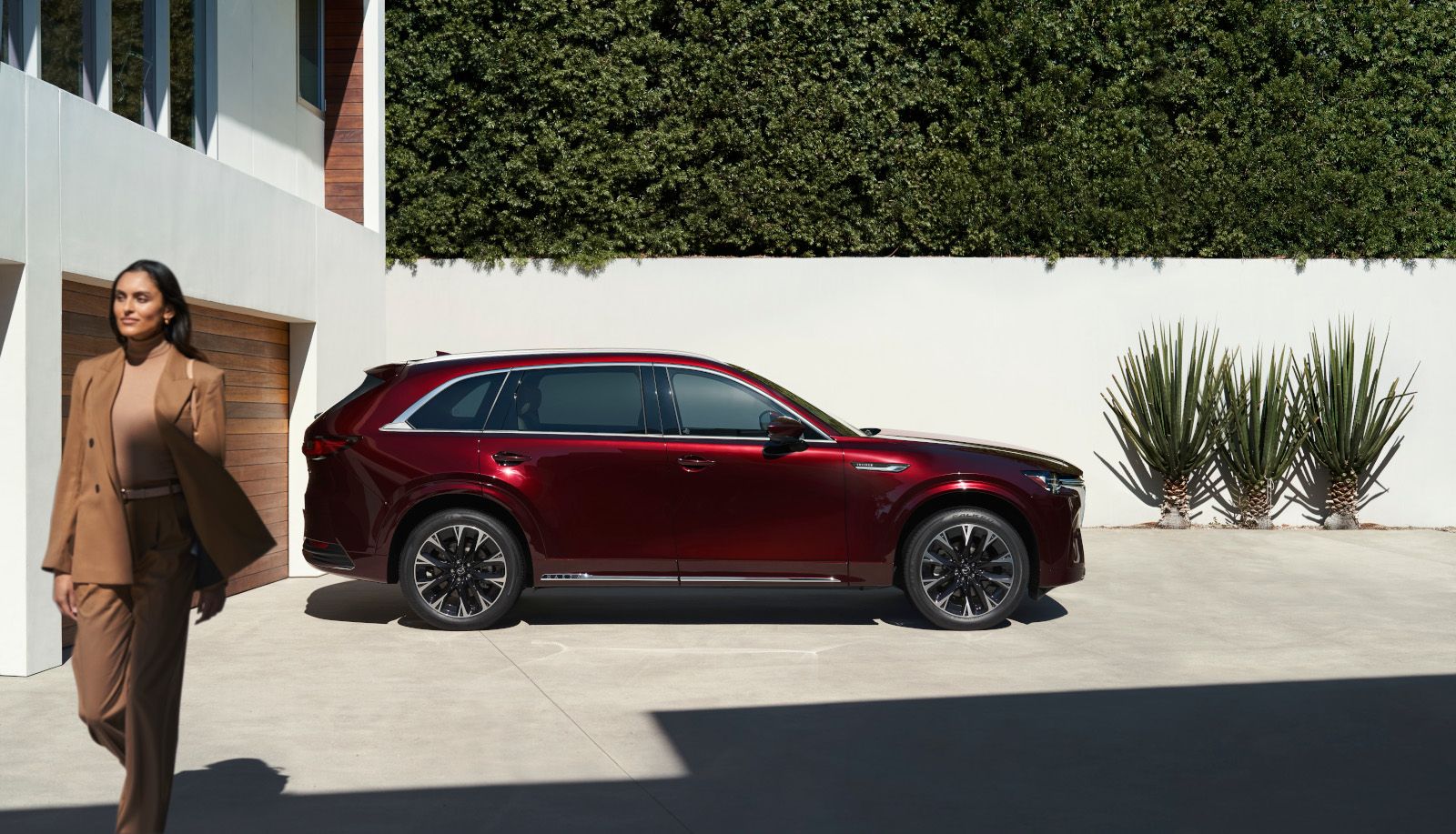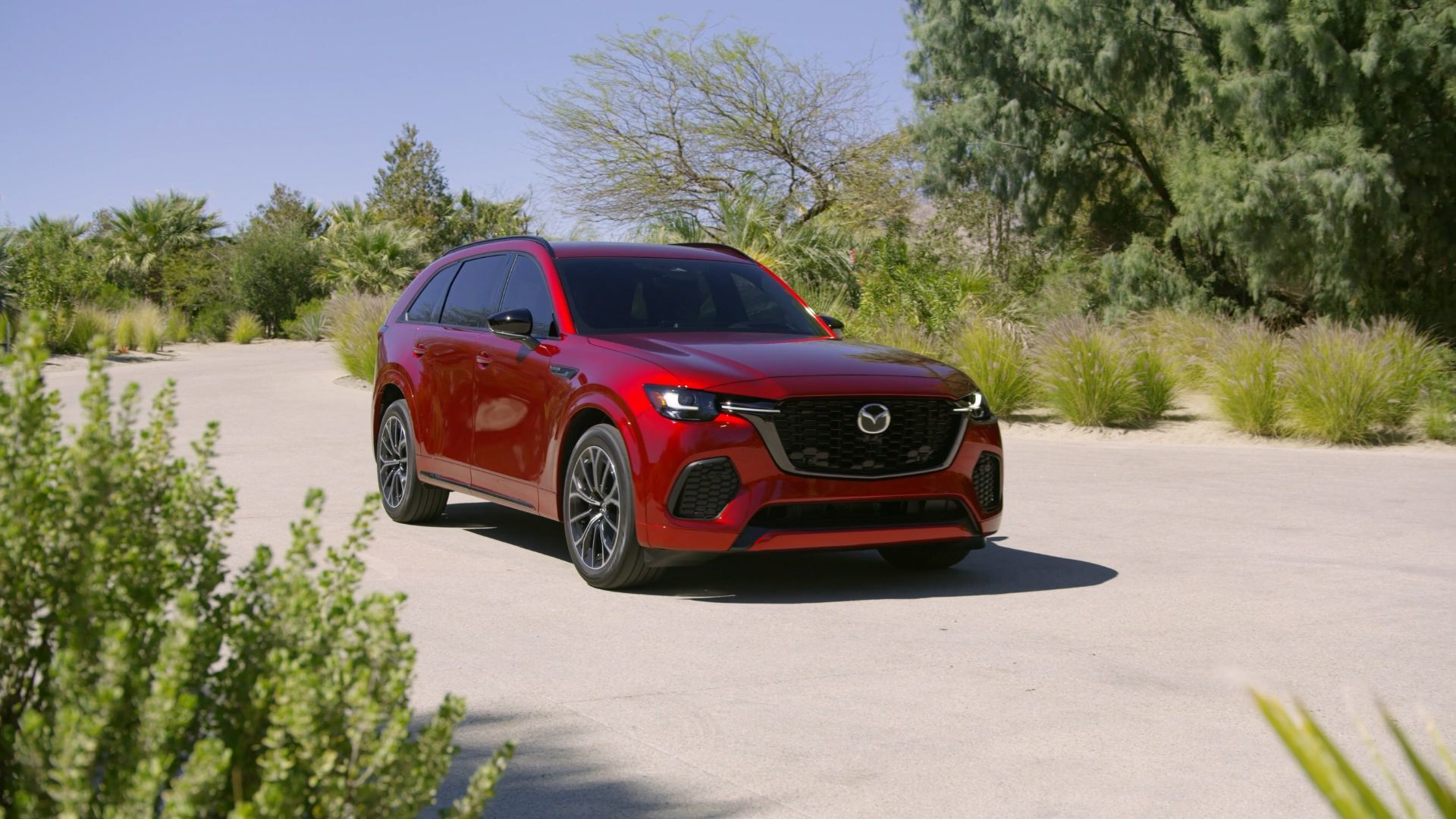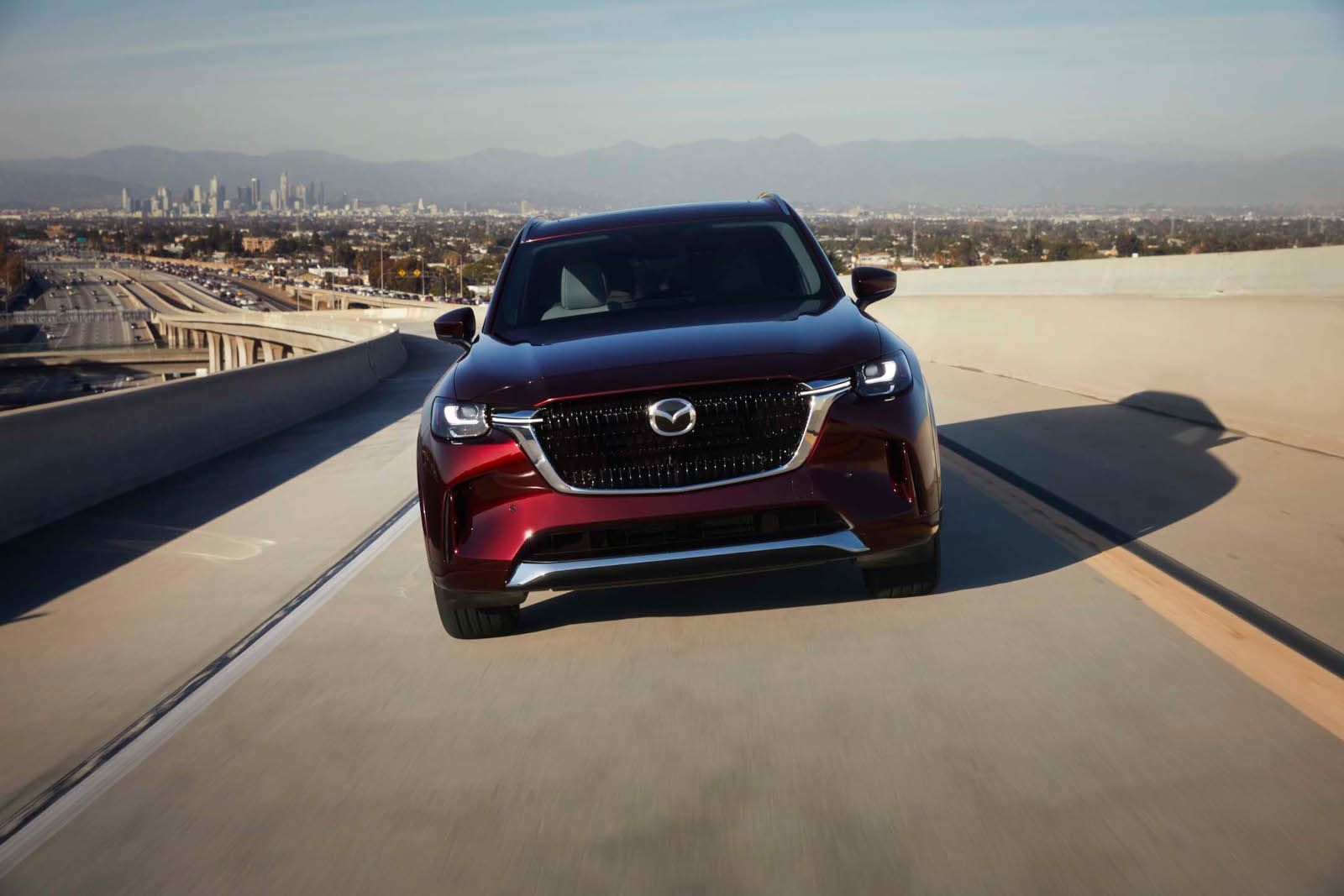Five Safety Technologies in the 2025 Mazda CX-90 That Protect Three-Row Families
November 13 2025,

The 2025 Mazda CX-90 earned the 2025 IIHS TOP SAFETY PICK+ award—the highest safety recognition available in the automotive industry. This achievement reflects more than strong crash-test performance. It confirms that Mazda's i-Activsense suite of driver-assistance technologies functions effectively in real-world British Columbia driving conditions, from crowded Metro Vancouver school zones to highway merges on the Trans-Canada.
For families transporting children, elderly passengers, or multiple occupants, understanding how specific safety systems work helps you use them effectively and know their limitations. The CX-90 includes dozens of safety features. These five technologies directly address the most common Metro Vancouver driving scenarios where three-row SUV families need protection.
Pedestrian Detection (Front and Rear Sensing)
Metro Vancouver presents constant pedestrian traffic. School drop-offs, mall parking lots, residential streets with playing children, and downtown crosswalks all require heightened awareness. The CX-90's dual pedestrian detection system monitors both ahead and behind the vehicle.
Forward-facing cameras and radar scan the road ahead, identifying pedestrians, cyclists, or objects in your path. If the system detects an imminent collision and you don't brake in time, it automatically applies emergency braking to avoid impact or reduce severity. The system operates at speeds up to 80 km/h, covering both urban and suburban driving.
Rear pedestrian detection activates when you shift into reverse. Backing out of driveways in British Columbia's residential neighbourhoods often means limited visibility due to parked cars, hedges, or sloped terrain. The rear sensors detect pedestrians crossing behind your vehicle—particularly children or pets who may not be visible in mirrors or backup cameras alone—and automatically brake if you don't stop in time.
Both systems work in varied lighting conditions, including the overcast weather common throughout Metro Vancouver. The technology considers daylight, dusk, and nighttime scenarios, ensuring consistent protection regardless of when you're driving.
Blind Spot Monitoring with Vehicle Exit Warning
Three-row SUVs create substantial blind spots due to their size, thick rear pillars, and the distance between the driver and rear corners. The CX-90's Blind Spot Monitoring (BSM) uses radar sensors mounted in the rear bumper to detect vehicles approaching from behind in adjacent lanes—a critical feature when merging onto Highway 1 or changing lanes during Lower Mainland commutes.
When a vehicle enters your blind spot, an indicator light appears in the corresponding side mirror. If you activate your turn signal while a vehicle occupies that space, the warning light flashes and an audible alert sounds, preventing potentially dangerous lane changes.
Vehicle Exit Warning extends this protection after parking. When you stop and turn off the ignition, the system continues monitoring traffic approaching from behind. If a passenger (particularly children in the third row) attempts to open a door while a vehicle, cyclist, or pedestrian approaches, the system provides visual and audible warnings to prevent "dooring" incidents—a particular concern in urban Burnaby parking situations or residential streets with bike lanes.
This feature addresses a specific three-row family scenario: children exiting the rear doors independently. Young passengers may not check for traffic before opening doors. Vehicle Exit Warning provides an additional layer of protection during these moments.
Mazda Radar Cruise Control with Stop & Go Function
British Columbia highway driving involves significant elevation changes and variable traffic density, particularly on routes like the Coquihalla or Sea-to-Sky Highway. The CX-90's Mazda Radar Cruise Control (MRCC) with Stop & Go function maintains a set distance from the vehicle ahead, automatically adjusting speed as traffic slows or accelerates.
Unlike basic cruise control that maintains only speed, MRCC uses millimeter-wave radar to track vehicles ahead. You set your desired speed and following distance (choosing between four distance settings). The system then modulates throttle and braking to maintain that gap, reducing driver fatigue during long trips—valuable when transporting three rows of passengers on multi-hour journeys.
The Stop & Go function works in heavy traffic. If traffic stops completely, the system brings the CX-90 to a full stop and holds position. When traffic resumes, a quick tap of the accelerator or resume button restarts the system, and it continues maintaining your set following distance. This transforms Lower Mainland rush hour driving from constant brake-and-gas inputs into more relaxed monitoring.
The system disengages if it detects that the driver is not actively monitoring the road—your hands must remain on the steering wheel. This prevents misuse while providing genuine assistance during appropriate situations. The technology works at speeds from stop up to approximately 145 km/h.
Lane-Keep Assist with Lane Departure Warning
Highway driving with a fully loaded three-row SUV requires attention to lane position, particularly during crosswinds on exposed bridges or when fatigued passengers create distractions. The CX-90's Lane-Keep Assist System (LAS) and Lane Departure Warning System (LDWS) work together to maintain proper lane position.
A forward-facing camera detects lane markings on the road. If you begin drifting out of your lane without activating a turn signal—common during momentary inattention or distraction—the system provides a visual dashboard warning and steering wheel vibration. If you don't correct course, the Lane-Keep Assist gently applies corrective steering torque to guide you back toward lane centre.
Emergency Lane Keeping, available on higher CX-90 trims, adds more assertive intervention. If the system determines you're at risk of leaving the road or colliding with an approaching vehicle due to lane departure, it applies stronger steering inputs and can modulate braking to help avoid the collision. This addresses scenarios like drowsiness during late-night family trips returning from weekend getaways.
The system recognizes its limitations. It requires clearly visible lane markings—faded lines on older British Columbia roads may not trigger the system. Snow or heavy rain that obscures markings also limits functionality. The technology assists attentive drivers but doesn't replace active steering and lane management.
Smart Brake Support Front with Pedestrian Detection

Stop-and-go Metro Vancouver traffic creates frequent collision risks. Following vehicles too closely, distracted moments checking rear passengers, or unexpected stops ahead all present dangers, particularly when transporting valuable cargo: your family.
Smart Brake Support Front (SBS-F) continuously monitors the road ahead using camera and radar technology. If the system determines you're approaching a vehicle or pedestrian too quickly and collision is imminent, it triggers three escalating interventions:
First, a visual and audible warning alerts you to brake. If you don't respond, the system pre-charges the brakes—preparing them for maximum stopping power when you do press the pedal. Finally, if you still haven't braked and collision is unavoidable, the system automatically applies full emergency braking to stop the vehicle or reduce impact severity.
The system operates at urban speeds where these collisions most commonly occur—functioning from approximately 4 km/h up to 80 km/h. This covers parking lot speeds, residential streets, school zones, and urban arterial roads throughout Burnaby and the Lower Mainland.
Important limitations exist. The system doesn't operate above 80 km/h. It cannot prevent all collisions—physics and stopping distances still apply. The technology provides additional reaction time and can prevent low-speed impacts, but it doesn't replace attentive driving and proper following distances.
Understanding System Limitations
These five technologies provide substantial protection, but they function as aids, not replacements for attentive driving. Each system has specific operational parameters:
- Weather conditions affect sensor performance. Heavy rain, snow, fog, or bright sunlight can temporarily reduce system effectiveness.
- Systems require clean sensors. Mud, snow, or debris covering cameras or radar sensors limits detection capability.
- Road conditions matter. Faded lane markings, construction zones, or unclear road edges challenge lane-keeping systems.
- Driver attention remains essential. These systems assist; they don't automate driving.
Reading your CX-90's owner's manual section on i-Activsense features helps you understand when each system activates, what triggers warnings, and how to respond appropriately to alerts.
IIHS Recognition Confirms Real-World Performance
The 2025 IIHS TOP SAFETY PICK+ award requires vehicles to meet strict criteria across multiple assessments. The CX-90 achieved top ratings in frontal crash tests, side-impact tests, roof strength, and head restraint evaluations. Critically, it also excelled in pedestrian crash prevention tests—directly validating the front pedestrian detection system discussed above.
IIHS testing specifically evaluates how well automated braking systems prevent crashes with pedestrians in various scenarios: an adult crossing in daylight, a child darting from between parked cars, and an adult crossing at night. The CX-90's performance confirms its safety systems work effectively in these challenging situations.
This external validation matters when selecting a three-row SUV for family transportation. The award confirms that Mazda's safety technology performs as designed in standardized testing that simulates real accident scenarios.
Additional Safety Considerations for Three-Row Families
Beyond the five technologies highlighted, the CX-90 includes several other features relevant to family protection:
Rear Seat Reminder: After opening a rear door before starting a trip, the system reminds you to check the rear seats before locking the vehicle—preventing accidentally leaving children or pets inside.
Child-Safety Rear Door Locks: Manual switches disable rear door interior handles, preventing young children from opening doors while the vehicle is moving.
LATCH Anchors: The second row includes three sets of Lower Anchors and Tethers for Children, accommodating three car seats across the bench. The third row provides two additional LATCH positions.
Rear Seat Belt Pretensioners: The CX-90 includes rear seat belt pretensioners with force limiters—technology that reduces injury risk for passengers in the second and third rows during frontal collisions.
Learn More at Metrotown Mazda
The 2025 Mazda CX-90's safety technology addresses real scenarios Metro Vancouver families encounter daily. From school drop-offs to highway trips, these five systems provide layers of protection that function when you need them most. Understanding how they work helps you drive more confidently and use the technology effectively.
Visit Metrotown Mazda in Burnaby to experience the CX-90's safety features firsthand and discover how Mazda's i-Activsense technology protects British Columbia families.






